
Abalone Cove State Marine Conservation Area (SMCA)
| 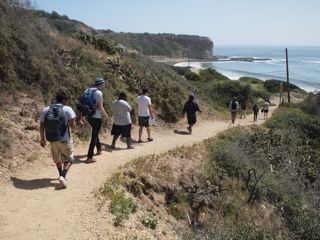
-
| 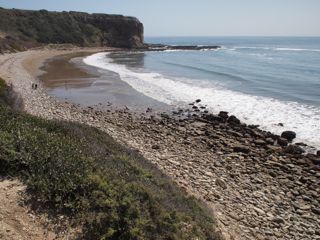
-
|
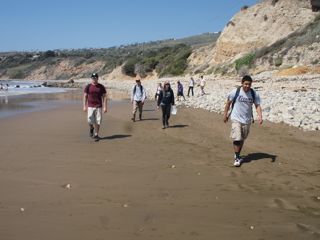
-
| 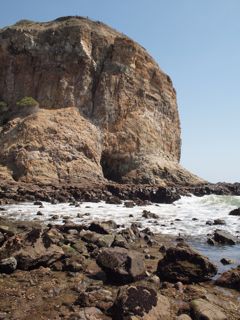
-
| 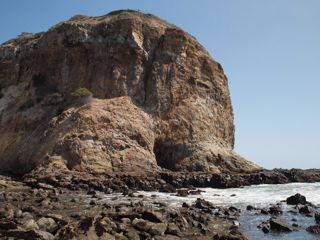
-
|
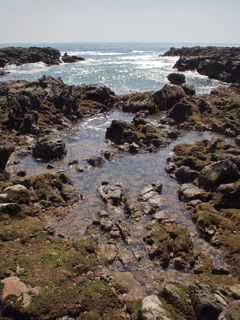
To the right is a giant keyhole limpet set into a
shallow tidepool
after finding it foot up, maybe 0.5m above the waterline. It looked responsive so I trust it will survive.
Assuming no previous visitor would be oblivious or mean enough to leave it that
way, I am left to speculate that it might have been hanging on to the side of a rock not helped much by that quite large slipper
limpet on its shell, perhaps also with balance affected when it fell? Or did a gull help it get that way? For the slipper limpet,
once it ran out of room with attachment restricted to the distance between the shell margin and the keyhole, it likely started to
get higher and wider but not any longer than it already is. What signal turns off the lengthening of the shell at the active growth margin, toward the keyhole?
| 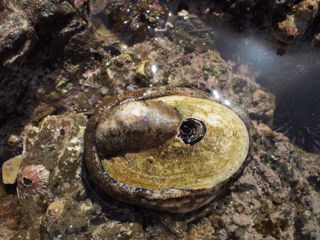
A fairly large
Megathura crenulata (giant keyhole limpet) with a large slipper limpet, provisionally identified here as Crepidula onyx
(onyx slipper limpet) attached. The latter species can
get up to 70 mm (2.7 inches) in length, larger than this one, so it is by far the largest slipper limpet species found in southern California.
Slipper limpets (or slipper snails) are sedentary suspension feeders that feed with
their gill on plankton or organic detritus, the latter quite possibly including keyhole limpet fecal matter
judging from its apparent access to the keyhole limpet's excrement in this image.
| 
Like some other slipper limpets, such as the well-studied C. fornicata from New
England, there can be a stack of up to 10 C. onyx. When one finds them in a stack, the larger (first settled) ones on the bottom will almost
certainly be females and those on the top are males. A newly settled male will eventually move down the pile as it grows and change sex
when it somewhere in the middle. This is an example of sequential hermaphroditism and was well documented
in a classic study by W. R. Coe (1942a; J. Morphol. 70: 501-512). However, C. onyx
raised in the lab in total isolation were over 90 percent males (Coe, 1942b; J. Morphol. 71: 35-51), whereas a different species
he studied in isolation were only 40 percent males. So is this a big but still lonely male or possibly a female with trouble getting all of its
brooded eggs fertilized?
|
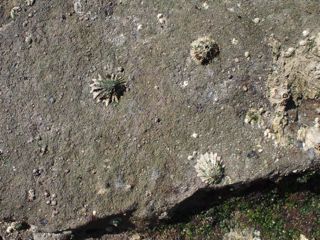
Lottia scabra (rough limpets) can get this large without being
removed by shorebird predators, or owl limpets defending their territories, because they make a home depression. Relatively few L. scabra,
were seen, which is possibly an indication that much of the substrate at this site is too hard for them to form home depressions. Even if they cannot make
a home depression, L. scabra are able to conform their shell growth to fit cracks and crevices.
| 
-
| 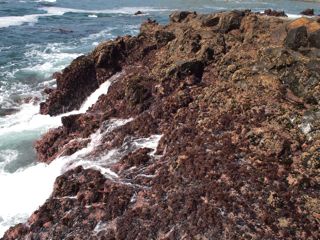
-
|

-
| 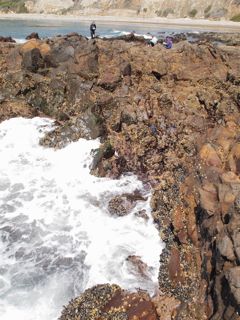
-
| 
-
|
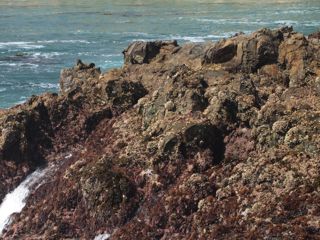
-
| 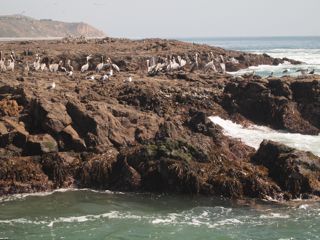
-
| 
-
|
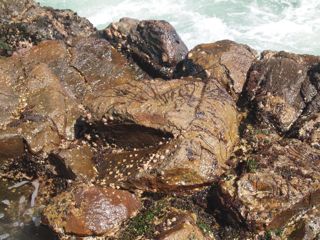
-
| 
-
| 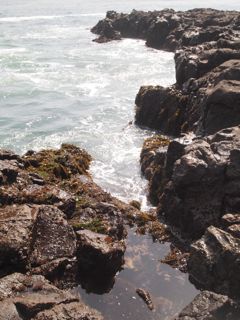
-
|
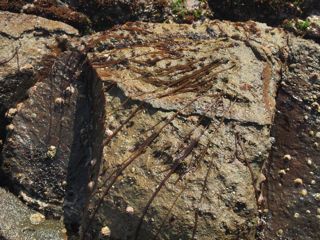
-
| 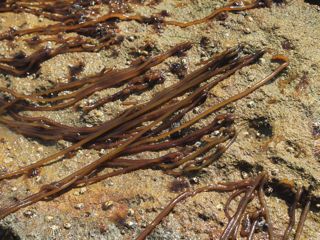
The red alga, Nemalion helminthoides, has been likened to gummy worms. It is very
stretchy. This is a common species in the North Atlantic, and the only sequences in GenBank are from there. This summer annual species is reported to be a world-wide
species on temperate shores. Is this really the same species in southern California? That hypothesis has not been tested with molecular data.
See here.
| 
-
|
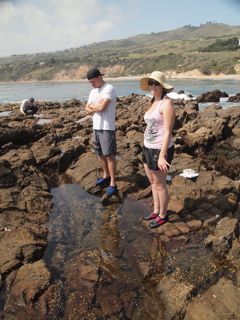
-
| 
-
| 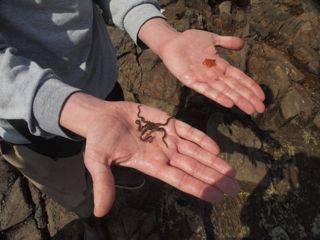
Ophiothrix spiculata and a juvenile Patiria miniata
|
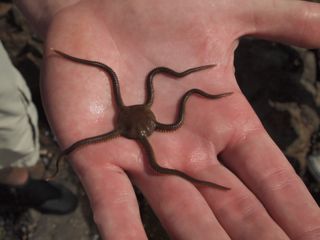
The brittle star, Ophioplocus esmarki, is rather sluggish in
its movement. It feeds on slow-moving small animals, which it passes to its jaws with tube feet along its arms.
| 
O. esmarki broods its embryos internally
with up to 100 juvenile brittle stars eventually emerging, possibly peaking in its reproduction during July where it has been studied (reviewed
in William Austin and Michael Hadfield's 1980 ophiuroid chapter in Morris et al.'s Intertidal Invertebrates of California).
| 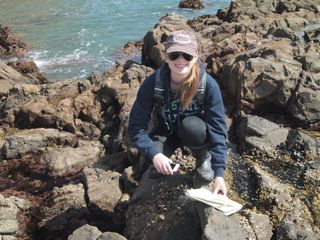
-
|
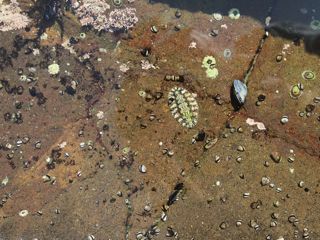
Molluscan grazers are likely responsible for the bare appearance of
this tidepool. The ones visible in this image include the chiton Nuttallina fluxa), the limpets Lottia strigatella (actually our
L. sp. B Hewson and Eernisse MS., a northern relative of L. strigatella), and the littorines Littorina keenae.
| 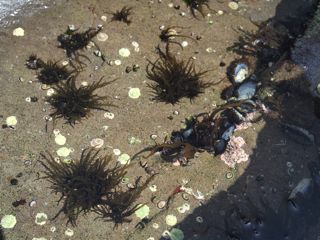
According to marine ecologist, Dr. Jayson Smith, this red alga is probably Chondrocanthus
spinosus. According to him, it is similar to the co-occurring Prionitis lanceoltata in being slimier than the latter, which is more
rigid. Also, the small branchlets on P. lanceolata tend to be more "leaf" shaped rather that just tiny straight branches.
| 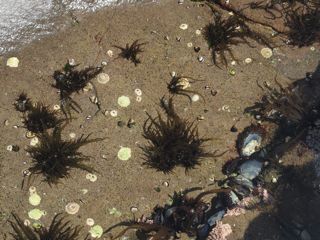
-
|
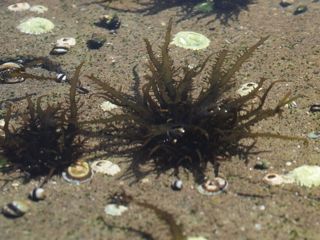
-
| 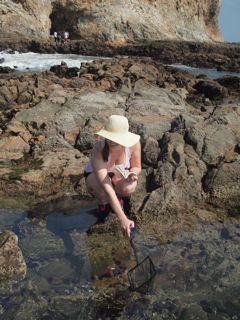
-
| 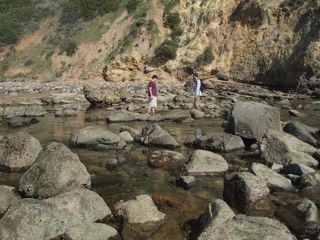
-
|
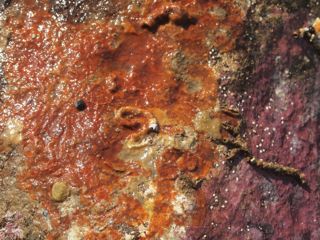
On this underside of this large rock, an orange bryozoan was covering
much of the surface, including a serpulid polychaete, Serpula vermicularis, which was very common at this site. The identity of the
bryozoan needs to be better investigated. It might be Eurystomella bilabiata, which can range in color from rose-red to red-orange, or brown
according to John Soule, Dorothy Soule, and Don Abbott's bryozoan chapter in Morris et al.'s Intertidal Invertebrates of California
(1980), but they say it is more common in central California.
| 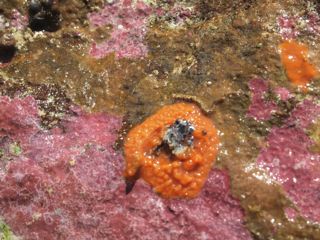
-
| 
-
|
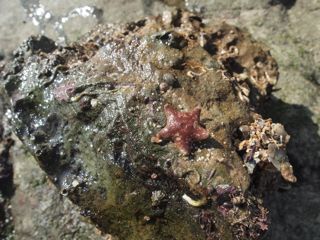
This is a juvenile bat star (Patiria miniata), but it is the
largest one of about 10 that I saw. This is consistent with what I have seen during the last decade. Only occasional adults are found in the
intertidal, although full-size adults are more commonly seen in offshore rock dredges. Are southern California shores too warm for them to get
large and common? Do they get eaten? This is a common species in central California.
| 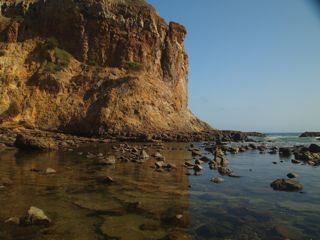
-
| 
-
|
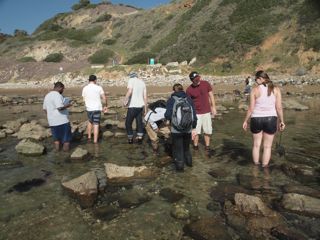
-
| 
-
| 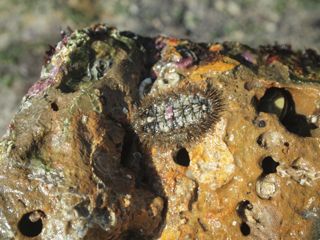
Mopalia muscosa (mossy chiton)
|
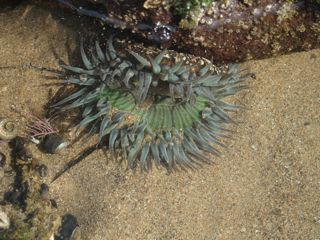
Anthopleura sola (sunburst anemone) seems to tolerate
being covered by sand.
| 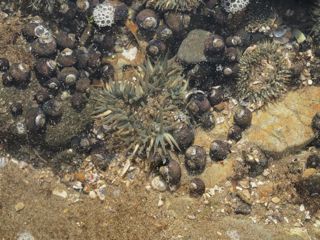
-
| 
The high protected shore had dense aggregations of Chlorostoma funebralis (black
turban snails).
|
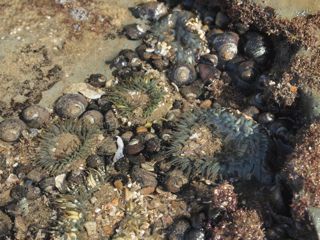
-
| 
-
| 
-
|

-
| 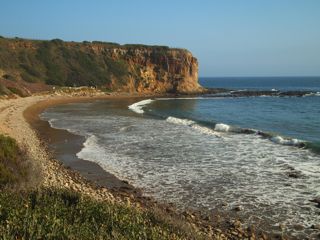
-
| 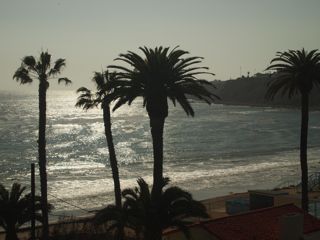
-
|
 Under Construction!
Under Construction! Under Construction!
Under Construction!